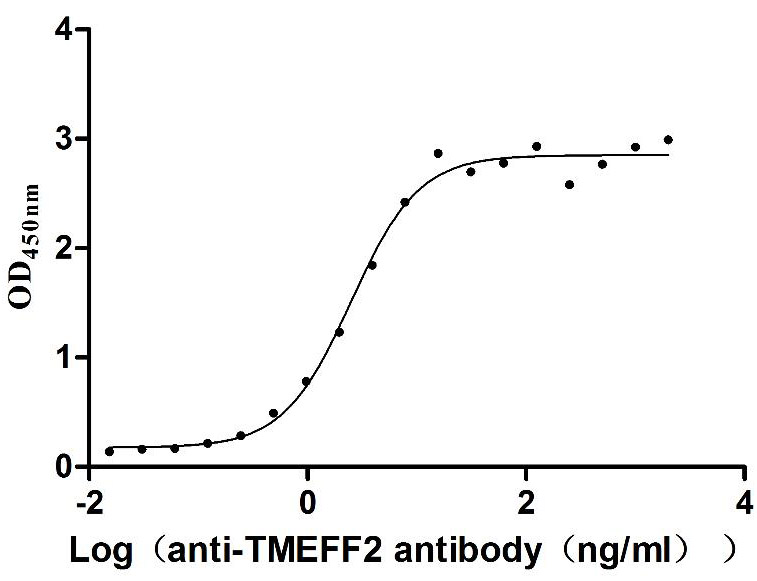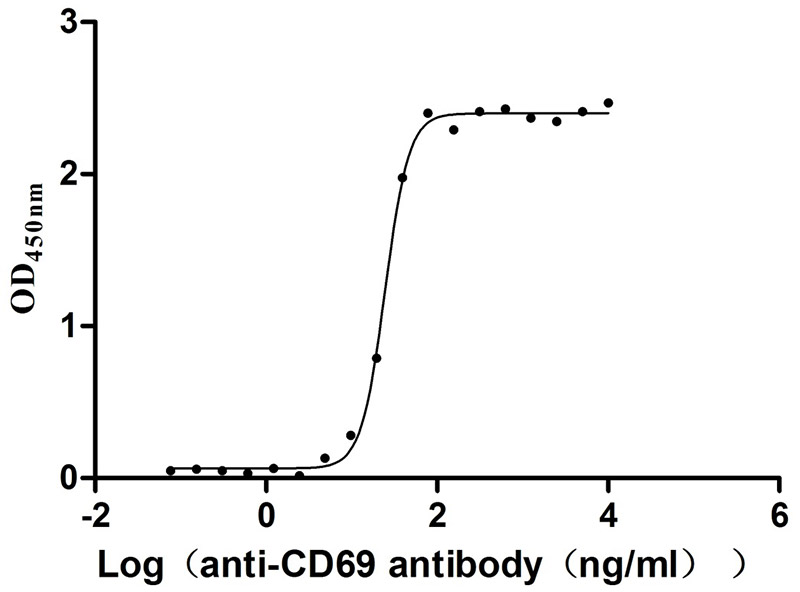Recombinant Rat Sodium/glucose cotransporter 1 (Slc5a1), partial
-
货号:CSB-YP021675RA
-
规格:
-
来源:Yeast
-
其他:
-
货号:CSB-EP021675RA
-
规格:
-
来源:E.coli
-
其他:
-
货号:CSB-EP021675RA-B
-
规格:
-
来源:E.coli
-
共轭:Avi-tag Biotinylated
E. coli biotin ligase (BirA) is highly specific in covalently attaching biotin to the 15 amino acid AviTag peptide. This recombinant protein was biotinylated in vivo by AviTag-BirA technology, which method is BriA catalyzes amide linkage between the biotin and the specific lysine of the AviTag.
-
其他:
-
货号:CSB-BP021675RA
-
规格:
-
来源:Baculovirus
-
其他:
-
货号:CSB-MP021675RA
-
规格:
-
来源:Mammalian cell
-
其他:
产品详情
-
纯度:>85% (SDS-PAGE)
-
基因名:
-
Uniprot No.:
-
别名:Slc5a1; Sglt1; Sodium/glucose cotransporter 1; Na(+)/glucose cotransporter 1; High affinity sodium-glucose cotransporter; Solute carrier family 5 member 1
-
种属:Rattus norvegicus (Rat)
-
蛋白长度:Partial
-
蛋白标签:Tag type will be determined during the manufacturing process.
The tag type will be determined during production process. If you have specified tag type, please tell us and we will develop the specified tag preferentially. -
产品提供形式:Lyophilized powder
Note: We will preferentially ship the format that we have in stock, however, if you have any special requirement for the format, please remark your requirement when placing the order, we will prepare according to your demand. -
复溶:We recommend that this vial be briefly centrifuged prior to opening to bring the contents to the bottom. Please reconstitute protein in deionized sterile water to a concentration of 0.1-1.0 mg/mL.We recommend to add 5-50% of glycerol (final concentration) and aliquot for long-term storage at -20℃/-80℃. Our default final concentration of glycerol is 50%. Customers could use it as reference.
-
储存条件:Store at -20°C/-80°C upon receipt, aliquoting is necessary for mutiple use. Avoid repeated freeze-thaw cycles.
-
保质期:The shelf life is related to many factors, storage state, buffer ingredients, storage temperature and the stability of the protein itself.
Generally, the shelf life of liquid form is 6 months at -20°C/-80°C. The shelf life of lyophilized form is 12 months at -20°C/-80°C. -
货期:Delivery time may differ from different purchasing way or location, please kindly consult your local distributors for specific delivery time.Note: All of our proteins are default shipped with normal blue ice packs, if you request to ship with dry ice, please communicate with us in advance and extra fees will be charged.
-
注意事项:Repeated freezing and thawing is not recommended. Store working aliquots at 4°C for up to one week.
-
Datasheet :Please contact us to get it.
靶点详情
-
功能:Actively transports glucose into cells by Na(+) cotransport with a Na(+) to glucose coupling ratio of 2:1. Efficient substrate transport in mammalian kidney is provided by the concerted action of a low affinity high capacity and a high affinity low capacity Na(+)/glucose cotransporter arranged in series along kidney proximal tubules.
-
基因功能参考文献:
- SGLT1 activity in lung alveolar cells of diabetic rats modulates airway surface liquid glucose concentration and bacterial proliferation. PMID: 26902517
- CG was mainly transported into the small intestinal cells by sodium-dependent glucose transporter 1. PMID: 26658676
- Present study indicated that inhibition of SGLT1 by phlorizin abrogated the beneficial effect of ischemic-preconditioning and for the first time, provides evidence that SGLT1 plays a crucial role in ischemic preconditioning-induced cardioprotection. PMID: 26920054
- Elevated SGLT activity increases Na+ influx into myocytes and causes Na+ overload in type 2 diabetes. PMID: 26316524
- Data indicate that there are several alternative channels for urea in the rat inner medulla that could potentially contribute to the high urea permeabilities in thin limb segments. PMID: 26423860
- These findings suggest that SGLT1 in the ventromedial hypothalamus plays a significant role in the detection and activation of counterregulatory responses to hypoglycemia. PMID: 26130763
- Chronic and direct silencing of basolateral Na-K-ATPase uniquely regulates brush border membrane Na absorptive pathways in intestinal epithelial cells. Specifically, SGLT1 is stimulated secondary to enhanced affinity of the cotransporter. PMID: 25652450
- Immunofluorescence experiments showed that NHE3 colocalizes with SGLT2 but not SGLT1 in the renal proximal tubule. PMID: 24652792
- Tunicamycin to inhibit glycosylation reduced SGLT1 activity. PMID: 24412219
- Lean and obese ZDF rats exhibited disruptions in circadian feeding. Glucose intolerance was evident in lean rats, but only obese rats developed diabetes and exhibited disrupted circadian rhythmicity of SGLT1 expression and function. PMID: 23633155
- Data suggest that contribution of Sglt1 to renal glucose reabsorption is greater under hypoglycemia than under hyperglycemia; as hypoglycemic agents, Sglt1-selective inhibitors carry a greater risk of causing hypoglycemia than Sglt2 inhibitors. PMID: 23249697
- down regulation of the expression of SGLT1 and brush border sucrase and lactase activities may be responsible for the observed malabsorption in G. lamblia infection PMID: 22905389
- High glucose induced cardiac myocyte p47phox translocation to the plasma membrane, resulting in SGLT1 dependent NOX2 activation. PMID: 21859816
- SGLT1 and rosmarinic acid modulate the trafficking of SGLT1 to the brush-border membrane and may contribute to the control of plasma glucose. PMID: 21433280
- Na/H exchange protein NHE3 and SGLT1 function together to regulate sodium absorption in the brush border membrane of intestinal epithelial cells. PMID: 21148403
- SGLT1 glucose uptake alleviated ischemia/reperfusion-induced barrier dysfunction and bacterial translocation, partly by inhibiting epithelial apoptosis via activation of PI3K/Akt signaling. PMID: 20975661
- the present findings show that diabetic- and/or hypertensive-induced changes in the sympathetic activity correlate with changes in SGLT1 expression in basolateral membrane of acinar cells PMID: 20841505
- SGLT1 appears to be also expressed in alveolar type I cells PMID: 20625908
- Infusion of sweetening agents into the small intestine resulted in rapid upregulation of sodium-glucose transporter SGLT1 in the Sprague-Dawley rat. PMID: 20395849
- These results suggest that a short amino acid sequence of the N-terminal domain of SGLT1 plays important roles in plasma membrane targeting and specific apical localization of the protein. PMID: 11831390
- the mechanism of absorption of quercetin-4'-glucoside involves both an interaction with SGLT1 and luminal hydrolysis by LPH, whereas quercetin-3-glucoside appears to be absorbed only following hydrolysis by LPH. PMID: 12663055
- Age-associated decline in glucose uptake was not explained by alterations in SGLT1, GLUT2 or Na+K(+)-ATPase. PMID: 14659592
- SGLT1 in capillaries of skeletal muscle is required for the action of insulin on D-glucose supply of myocytes PMID: 14733905
- Food intake, rather than the light cycle, greatly affects the diurnal rhythm of SGLT1 and PEPT1 expressions. PMID: 15333706
- Long-term hyperglycaemia leaves SGLT-1 unchanged. PMID: 15662550
- Rapid inhibition of glucose-induced short-current circuit by leptin was associated with a parallel decrease in the abundance of sodium-glucose transporter-1 in brush border membranes. PMID: 15677491
- in SGLT1, Cd2+ binding to the CXXC motif induces conformational changes that cause a partial inhibition of d-glucose transport PMID: 15829715
- in the rat kidney, the expression of SGLT1 is represented by a 75-kDa protein localized largely in the PT S3 segments, where it exhibits gender differences (F > M) at both the protein and mRNA levels that are caused by androgen inhibition PMID: 16204409
- identified GLUT-1 to -5 and SGLT-1 in the endothelial cells of cerebral, renal, and mesenteric arteries PMID: 17090404
- Luminal leptin inhibited intestinal sugar absorption at low galactose concentrations, which indicates that leptin regulates SGLT1 activity in vivo. PMID: 17488247
- Spermidine induction of SGLT1 in small intestine may be mediated by altered ornithine decarboxylase expression. PMID: 17673438
- RSC1A1 codes for a 67-kDa protein named RS1 that mediates transcriptional and post-transcriptional regulation of Na(+)-D-glucose cotransporter SGLT1. PMID: 17686765
- Indicate enterocytes are able to synthesize AngII to rapidly inhibit SGLT1-mediated glucose transport. PMID: 17702818
- SGLT1 transcription is independent of the vagus. However, dissociation of the protein rhythm from the underlying mRNA signal by vagotomy suggests the vagus may be involved in posttranscriptional regulation of SGLT. PMID: 18308853
- These results indicate that decreased cNO levels directly mediate the inhibition of SGLT1 and stimulation of NHE3 in intestinal epithelial cells. PMID: 18325982
- The localization of SGLT1 in adult and prepubertal rat organs was studied using immunohistochemistry, western blotting, and RT-PCR. PMID: 18524944
- Diurnal changes in intestinal glucose uptake capacity is linked to changes in both SGLT1 mRNA and protein. PMID: 18549898
- The antidiabetic effect of tungstate is partly due to normalization of the activity of sucrase and SGLT1 in the brush-border membrane of enterocytes. PMID: 18617558
- Data show that SGLT1 levels in diabetic obese rats were 1.6 folds higher than age-matched leans, respectively. PMID: 19095325
- The persistence of SGLT1 rhythmicity in isolated loops of jejunum indicates that diurnal induction is independent of local luminal nutrient delivery, and it suggests a reliance on systemic entrainment pathways. PMID: 19231582
- Diabetes increases SLC5A1 gene expression in salivary glands, increasing the SGLT1 protein content in the luminal membrane of ductal cells, which, by increasing water reabsorption, might explain the diabetes-induced decrease in salivary secretion. PMID: 19238474
显示更多
收起更多
-
亚细胞定位:Membrane; Multi-pass membrane protein.
-
蛋白家族:Sodium:solute symporter (SSF) (TC 2.A.21) family
-
数据库链接:
KEGG: rno:25552
STRING: 10116.ENSRNOP00000024165
UniGene: Rn.10224
Most popular with customers
-
Recombinant Rat Intestinal-type alkaline phosphatase 1 (Alpi) (Active)
Express system: Mammalian cell
Species: Rattus norvegicus (Rat)
-
Recombinant Rat Microtubule-associated protein tau (Mapt) (Active)
Express system: Mammalian cell
Species: Rattus norvegicus (Rat)
-
Recombinant Human Glucagon-like peptide 1 receptor (GLP1R), partial (Active)
Express system: Mammalian cell
Species: Homo sapiens (Human)
-
Recombinant Human Tomoregulin-2 (TMEFF2), partial (Active)
Express system: Mammalian cell
Species: Homo sapiens (Human)
-
Recombinant Human Early activation antigen CD69 (CD69), partial (Active)
Express system: Mammalian cell
Species: Homo sapiens (Human)
-
Recombinant Human Transferrin receptor protein 1 (TFRC), partial (Active)
Express system: Mammalian cell
Species: Homo sapiens (Human)
-
Recombinant Mouse Gastric inhibitory polypeptide receptor (Gipr), partial (Active)
Express system: Mammalian cell
Species: Mus musculus (Mouse)
-
Recombinant Human Carcinoembryonic antigen-related cell adhesion molecule 8(CEACAM8) (Active)
Express system: Mammalian cell
Species: Homo sapiens (Human)




















